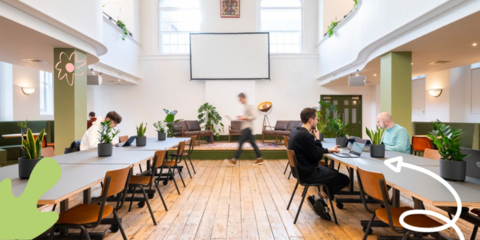How online coworking is shaping the future of work

By Annie Button
•
Nov 29, 2023
Coworking spaces have become increasingly popular over the last few years, particularly since the pandemic. These shared work environments offer freelancers, remote workers and companies access to affordable office infrastructure and a sense of community.
Thrust upon many organisations by the 2020 global lockdowns, the rapid shift to remote/hybrid working models has driven new approaches to collaboration and work patterns. Let’s take a look at how these changes are impacting current work paradigms, and the role of online coworking.
What is online coworking?
Online coworking aims to recreate the communal workspace experience in a remote setting. This involves providing users with virtual spaces to collaborate, network, and socialize together online. Several platforms have emerged to facilitate meaningful online coworking and transform remote work into a more engaging experience, with FLOWN being amongst those at the forefront.
FLOWN focuses on promoting accountability, productivity, and work-life balance through features like body doubling and communal work sessions. Along with member events and networking, users can join scheduled coworking sessions to partner up with others, share intentions, and keep each other focused as they work.
Another popular platform is Remo, which allows users to network in virtual two-dimensional spaces with embeddable apps and games. This brings an element of fun and connection to the online coworking experience.
These platforms, combined with enabling technologies like digital whiteboards, VR, and spatial audio, showcase the potential to make online coworking an immersive environment for getting things done and networking with professionals from all over the world. The solutions continue to evolve, but it is clear that online coworking is here to stay, for a number of reasons.
The benefits of online coworking
Online coworking offers several advantages that make it an appealing remote work option:
Flexibility: Workers can join coworking sessions from anywhere with an internet connection, allowing true location independence while virtual coworking in any setting. This provides greater flexibility to travel, relocate, or split time between multiple places.
Networking: Coworking platforms make networking easier by connecting professionals based on their interests, skills, and availability for collaboration. The variety of spaces and interactive events also enables this new way of building relationships.
Sustainability: Virtual coworking eliminates commutes and reduces the energy/resources needed to maintain physical offices. This makes it an environmentally friendly work alternative.
Cost Savings: With online coworking, there’s no leased office space required. Most online coworking platforms offer tiered pricing or usage-based plans, creating cost efficiency.
Community: For remote workers feeling isolated, virtual coworking provides a sense of community through shared spaces and discussions. The atmosphere can mimic the social workplace environment that remote workers often miss.
Work-Life Balance: The flexibility lets people more easily balance work with appointments, errands, exercise and family time throughout the day.
How I found flow and beat burnout
Hear about Amanda’s story
of learning to achieve flow
states and beat burnout
with virtual coworking.

The challenges of online coworking
While online coworking provides many benefits for employees and employers alike, it also comes with potential downsides to consider. One is the struggle to stay focused without the structures of a traditional office — it can be all too easy to procrastinate or get distracted in a home environment and this can negatively impact productivity and blur work-life boundaries. Isolation can also creep in without the organic social interactions of an office. This makes choosing an effective virtual coworking platform especially important.
There’s also a learning curve with online coworking to become fluent with new virtual tools and platforms, and technical difficulties like laggy connectivity or audio issues can disrupt the flow during virtual sessions.
Workers may also feel pressure to always “be on" if the separation between work and personal life is not set. Finding balance is key. While the flexibility of online coworking provides many positives, individuals have to be self-disciplined to manage potential downsides relating to focus, isolation, tech barriers, and work-life balance.
Addressing the challenges
While online coworking comes with some potential pitfalls, there are solutions to mitigate the common difficulties faced. One effective strategy is body doubling, or working in the virtual presence of someone else. Having a “body double” provides mutual accountability and motivation to stay focused on the agreed upon tasks.
Online coworking platforms have tapped into the concept of body doubling along with other features that aim to boost productivity and engagement. FLOWN specifically facilitates body doubling by enabling focus sessions to help boost motivation, reduce procrastination and achieve defined goals.
In addition to body doubling, other solutions include creating set work hours, dressing professionally, dedicating a workspace at home, and incorporating video calls to combat isolation. Taking breaks to stretch, snack, or chat with a coworker can also be beneficial. Using external apps like FocusKeeper or Freedom can help minimize digital distractions as well.
The future of online coworking
Online coworking is still in its early stages, with significant room to evolve as technology progresses. One area is integration with augmented and virtual reality. AR/VR tools could transport online coworking to simulated 3D workspaces, making interactions more immersive. Spatial audio may also enhance the feeling of working alongside colleagues.
As the 4-day work week gains more traction, condensed schedules could benefit from focused online coworking sessions to maximize productivity. The flexibility of virtual spaces allows workers to easily access collaborative environments even with non-traditional hours.
Artificial intelligence may also personalize online coworking experiences by assessing user traits and preferences to make appropriate platform recommendations and match compatible work partners. And as the metaverse develops, we may see virtual reality coworking spaces become a more integrated extension of our work lives.
Why online coworking is here to stay
While the future is difficult to predict, it is likely that online coworking will move toward offering up ever more immersive experiences. Although the technology may change, online coworking seems poised to transform when, where, and how we work in the coming decades and beyond. But however our work paradigms continue to evolve, what’s clear is that the fundamental human need for meaningful connection and accountability will remain integral.

















